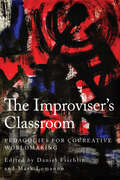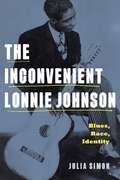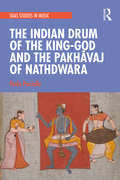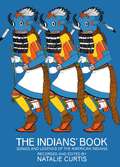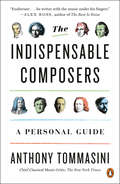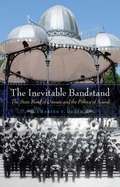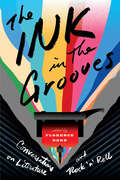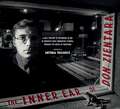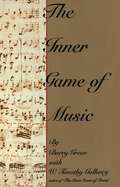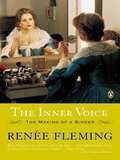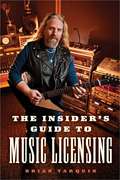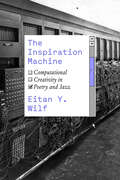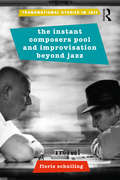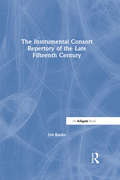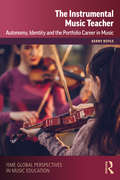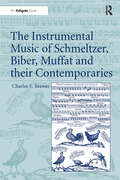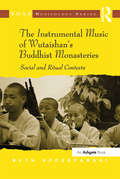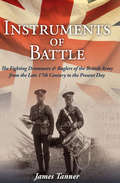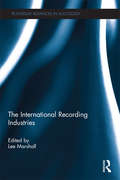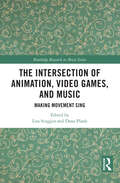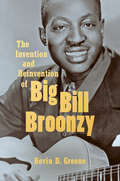- Table View
- List View
The Improviser's Classroom: Pedagogies for Cocreative Worldmaking (Insubordinate Spaces)
by Daniel Fischlin Mark LomannoAn adept improviser can find ways forward amid impasse, agency amid oppression, and community amid division. The editors and contributors to The Improviser’s Classroom present an array of critical approaches intended to reimagine pedagogy through the prisms of activism, reciprocity, and communal care. Demonstrating how improvisation can inform scenes of teaching and learning, this volume also outlines how improvisatory techniques offer powerful, if not vital, tools for producing connection, creativity, accompaniment, reciprocity, meaningful revelation, and lifelong curiosity. The Improviser's Classroom champions activist pedagogies and the public work essential for creating communities bound together by reciprocal care and equity. Contributors: Sibongile Bhebhe, Judit Csobod, Michael Dessen, jashen edwards, Kate Galloway, Tomie Hahn, Petro Janse van Vuuren, Lauren Michelle Levesque, George Lipsitz, Rich Marsella, Tracy McMullen, Hafez Modirzadeh, Ed Sarath, Joe Sorbara, Jesse Stewart, Ellen Waterman, Carey West, and the editors
The Inconvenient Lonnie Johnson: Blues, Race, Identity (American Music History)
by Julia SimonLonnie Johnson is a blues legend. His virtuosity on the blues guitar is second to none, and his influence on artists from T-Bone Walker and B. B. King to Eric Clapton is well established. Yet Johnson mastered multiple instruments. He recorded with jazz icons such as Duke Ellington and Louis Armstrong, and he played vaudeville music, ballads, and popular songs.In this book, Julia Simon takes a closer look at Johnson’s musical legacy. Considering the full body of his work, Simon presents detailed analyses of Johnson’s music—his lyrics, technique, and styles—with particular attention to its sociohistorical context. Born in 1894 in New Orleans, Johnson's early experiences were shaped by French colonial understandings of race that challenge the Black-white binary. His performances call into question not only conventional understandings of race but also fixed notions of identity. Johnson was able to cross generic, stylistic, and other boundaries almost effortlessly, displaying astonishing adaptability across a corpus of music produced over six decades. Simon introduces us to a musical innovator and a performer keenly aware of his audience and the social categories of race, class, and gender that conditioned the music of his time. Lonnie Johnson’s music challenges us to think about not only what we recognize and value in “the blues” but also what we leave unexamined, cannot account for, or choose not to hear. The Inconvenient Lonnie Johnson provides a reassessment of Johnson’s musical legacy and complicates basic assumptions about the blues, its production, and its reception.
The Indian Drum of the King-God and the Pakhāvaj of Nathdwara (SOAS Studies in Music)
by Paolo PacciollaThe book studies the evolution of the ancient drum mṛdaṅga into the pakhāvaj, crossing more than 2,000 years of history. While focusing on the Nathdwara school of pakhāvaj, the author joins ethnographic, historical, religious and iconographic perspectives to argue a multifaceted interpretation of the role and function of the pakhāvaj in royal courts, temples and contemporary stages. Furthermore, he offers the first analysis of the visual and narrative contents of its repertoire.
The Indians' Book
by Natalie CurtisLore, music, narratives, dozens of drawings by Indians themselves from an authoritative and important survey of native culture among Plains, Southwestern, Lake, and Pueblo Indians. Standard work in popular ethnomusicology. Features 149 songs in full notation. Includes 23 drawings and 23 photos.
The Indispensable Composers: A Personal Guide
by Anthony TommasiniAn exploration into the question of greatness from the Chief Classical Music Critic of the New York TimesWhen he began to listen to the great works of classical music as a child, Anthony Tommasini had many questions. Why did a particular piece move him? How did the music work? Over time, he realized that his passion for this music was not enough. He needed to understand it. Take Bach, for starters. Who was he? How does one account for his music and its unshakeable hold on us today? As a critic, Tommasini has devoted particular attention to living composers and overlooked repertory. But, like all classical music lovers, the canon has remained central for him. In 2011, in his role as the Chief Classical Music Critic for the New York Times, he wrote a popular series in which he somewhat cheekily set out to determine the all-time top ten composers. Inviting input from readers, Tommasini wrestled with questions of greatness. Readers joined the exercise in droves. Some railed against classical music’s obsession with greatness but then raged when Mahler was left off the final list. This intellectual game reminded them why they loved music in the first place. Now in THE INDISPENSABLE COMPOSERS, Tommasini offers his own personal guide to the canon--and what greatness really means in classical music. What does it mean to be canonical now? Who gets to say? And do we have enough perspective on the 20th century to even begin assessing it? To make his case, Tommasini draws on elements of biography, the anxiety of influence, the composer's relationships with colleagues, and shifting attitudes toward a composer's work over time. Because he has spent his life contemplating these titans, Tommasini shares impressions from performances he has heard or given or moments when his own biography proves revealing. As he argues for his particular pantheon of indispensable composers, Anthony Tommasini provides a masterclass in what to listen for and how to understand what music does to us.
The Inevitable Bandstand: The State Band of Oaxaca and the Politics of Sound (The Mexican Experience)
by Charles V. HeathIn the hands of the state, music is a political tool. The Banda de Música del Estado de Oaxaca (State Band of Oaxaca, BME), a civil organization nearly as old as the modern state of Oaxaca itself, offers unique insights into the history of a modern political state. In The Inevitable Bandstand, Charles V. Heath examines the BME’s role as a part of popular political culture that the state of Oaxaca has deployed in an attempt to bring unity and order to its domain. The BME has always served multiple functions: it arose from musical groups that accompanied military forces as they trained and fought; today it performs at village patron saint days and at Mexico’s patriotic celebrations, propagating religions both sacred and civic; it offers education in the ways of liberal democracy to its population, once largely illiterate; and finally, it provides respite from the burdens of life by performing at strictly diversionary functions such as serenades and Sunday matinees. In each of these government-sanctioned roles, the BME serves to unify, educate, and entertain the diverse and fragmented elements within the state of Oaxaca, thereby mirroring the historical trajectory of the state of Oaxaca and the nation of Mexico from the pre-Hispanic and Spanish colonial eras to the nascent Mexican republic, from a militarized and fractured young nation to a consolidated postrevolutionary socialist state, and from a predominantly Catholic entity to an ostensibly secular one.
The Ink in the Grooves: Conversations on Literature and Rock 'n' Roll
by Florence DoreDrop the record needle on any vinyl album in your collection, then read the first pages of that novel you've been meaning to pick up—the reverberations between them will be impossible to miss. Since Dylan went electric, listening to rock 'n' roll has often been a surprisingly literary experience, and contemporary literature is curiously attuned to the history and beat of popular music. In The Ink in the Grooves, Florence Dore brings together a remarkable array of acclaimed novelists, musicians, and music writers to explore the provocatively creative relationship between musical and literary inspiration: the vitality that writers draw from a three-minute blast of guitars and the poetic insights that musicians find in literary works from Shakespeare to Southern Gothic. Together, the essays and interviews in The Ink in the Grooves provide a backstage pass to the creative processes behind some of the most exciting and influential albums and novels of our time.Contributors: Laura Cantrell, Michael Chabon, Roddy Doyle, Bob Dylan, Steve Earle, William Ferris, Dom Flemons, Rhiannon Giddens, Dave Grohl, Peter Guralnick, Amy Helm, Randall Kenan, Jonathan Lethem, Greil Marcus, Rick Moody, Lorrie Moore, the John Prine band (Dave Jacques, Fats Kaplin, Pat McLaughlin, Jason Wilber), Dana Spiotta, John Jeremiah Sullivan, Richard Thompson, Scott Timberg, Daniel Wallace, Colson Whitehead, Lucinda Williams, Warren Zanes.
The Inner Ear of Don Zientara: A Half Century Of Recording In One Of America's Most Innovative Studios, Through The Voices Of Musicians
by Antonia TricaricoA photo-filled oral history of the DC-area music studio that brought us some of the most iconic recordings by Bad Brains, Bikini Kill, Fugazi, and so many more. In the late 1970s, Don Zientara—a conscientious objector to the Vietnam War—founded Inner Ear Studio in the basement of his home in Arlington, VA, using the electronics training he received from the army. Inner Ear remained in Don's basement until its 1990 relocation to a larger space on South Oakland Street. Along the way, Inner Ear became best known for recording iconic DC punk musicians including Bad Brains, Minor Threat, Bikini Kill, Rites of Spring, Mary Timony, and Fugazi. Composed by photographer Antonia Tricarico, The Inner Ear of Don Zientara is an oral history of not just Inner Ear's recordings, but the role that Don played in creating one of the most welcoming and nurturing recording studios the world over. Alongside 250 photographs, this volume includes testimonials from members of Fugazi, Scream, Fire Party, Shudder to Think, Jawbox, the Red Hot Chili Peppers, and Dismemberment Plan, as well as musicians like Kathleen Hanna and Henry Rollins, among other notables. In addition to DC punk bands, Don also recorded many other styles and genres, including Celtic folk tunes, harp music, Russian balalaika groups, political advertisers, and choral singers. The studio was also featured on Dave Grohl’s Sonic Highways television mini-series. The Inner Ear of Don Zientara pays tribute to this iconic studio, celebrating the man at the heart of this remarkable space.
The Inner Game of Music
by W. Timothy Gallwey Barry GreenThe book offers a way to acknowledge and overcome the obstacles one has to overcome in order to bring a new quality to the experience of learning of music.
The Inner Light: How India Influenced the Beatles
by Susan ShumskyThe hidden meanings of the Beatles&’ most esoteric lyrics and sounds are revealed by a rare insider who spent two decades with the man who made &“meditation,&” &“mantra,&” and &“yoga&” household words: Maharishi Mahesh Yogi. &“I absolutely love this book. Between the stories and the pictures, many I&’ve not seen before, this is truly a spiritual journey.&” —Chris O&’Dell, author of Miss O&’Dell, My Hard Days and Long Nights with The Beatles, The Stones, Bob Dylan, and the Women They LovedThe spiritual journey of the Beatles is the story of an entire generation of visionaries in the sixties who transformed the world. The Beatles turned Western culture upside down and brought Indian philosophy to the West more effectively than any guru. The Inner Light illumines hidden meanings of the Beatles&’ India-influenced lyrics and sounds, decoded by Susan Shumsky—a rare insider who spent two decades in the ashrams and six years on the personal staff of the Beatles&’ mentor, Maharishi Mahesh Yogi. &“With clarity, depth, and impeccable research, an exceptionally comprehensive book filled with engaging tales and fresh insights that even diehard Beatles fans will find illuminating.&” —Philip Goldberg, author of American Veda: From Emerson and The Beatles to Yoga and Meditation, How Indian Spirituality Changed the West This eye-opening book draws back the curtain on the Beatles&’ experiments with psychedelics, meditation, chanting, and Indian music. Among many shocking revelations never before revealed, we discover who invented "raga rock" (not the Beatles), the real identity of rare Indian instruements and musicians on their tracks, which Beatle was the best meditator (not George), why the Beatles left India in a huff, John and George&’s attempts to return, Maharishi&’s accurate prediction, and who Sexy Sadie, Jojo, Bungalow Bill, Dear Prudence, Blackbird, My Sweet Lord, Hare Krishna, and the Fool on the Hill really were. &“This book reminds us in illuminating fashion why Susan is the premier thinker about India&’s key influence upon the direction of the Beatles&’ art. In vivid and stirring detail, she traces the Fabs&’ spiritual awakening from Bangor to Rishikesh and beyond.&” —Kenneth Womack, author of John Lennon 1980: The Last Days in the Life Half a century later, the Beatles have sold more records than any other recording artist. A new generation wants to relive the magic of the flower-power era and is now discovering the message of this iconic band and its four superstars. For people of all nations and ages, the Beatles&’ mystique lives on. The Inner Light is Susan Shumsky&’s gift to their legacy.
The Inner Voice: The Making of a Singer
by Renee FlemingThe fascinating personal story of one of the most celebrated talents in today's music scene The star of the Metropolitan Opera's recent revival of Dvorak's Rusalka, soprano Renée Fleming brings a consummately beautiful voice, striking interpretive talents, and compelling artistry to bear on performances that have captivated audiences in opera houses and recital halls throughout the world. In The Inner Voice--a book that is the story of her own artistic development and the "autobiography" of her voice--this great performer presents a unique and privileged look at the making of a singer and offers hard-won, practical advice to aspiring performance artists everywhere. From her youth as the child of two singing teachers through her years at Juilliard, from her struggles to establish her career to her international success, The Inner Voice is a luminous, articulate, and candid self-portrait of a contemporary artist--and the most revelatory examination yet of the performing life.
The Inside Songs of Amiri Baraka (Palgrave Studies in Music and Literature)
by Aldon Lynn NielsenThe Inside Songs of Amiri Baraka examines the full length of Baraka’s discography as a poet recording with musicians as well as his contributions to jazz and R & B, beginning with his earliest studio recordings in 1965 and continuing to the last year of his life, 2014. This recorded history traces his evolution from the era of Beat poetry and “projective verse,” through the period of the Black Arts Movement and cultural nationalism, and on to his commitments to “third world Marxism,” which characterized the last decades of his life. The music enfolding Baraka’s recitations ranges from traditional African drumming, to doo wop, rhythm and blues, soul and the avant garde jazz that was his great love and the subject of so much of his writing, and includes both in-studio sessions and live concert performances. This body of work offers a rare opportunity to think about not only jazz/poetry, but the poet in the recording studio and the relations of text to score.
The Insider's Guide to Music Licensing
by Brian TarquinFirst-hand advice for musicians from Brian Tarquin, author, who has over twenty years of experience in licensing music to record labels, TV shows, feature films, radio promos, and network promos. This book takes you through how licensing really works: what type of royalties are expected, digital royalties from companies, receiving royalties from iTunes, Rhapsody, Napster through digital distributors like IODA/The Orchard, and how they pay. Also covered are mechanical royalties from broadcast radio licenses, how foreign royalties are collected, publishing administration deals, and a breakdown of sync and master licenses. Interviews with major industry players offer advice directly to musicians.
The Inspiration Machine: Computational Creativity in Poetry and Jazz
by Eitan Y. WilfExplores how creative digital technologies and artificial intelligence are embedded in culture and society. In The Inspiration Machine, Eitan Y. Wilf explores the transformative potentials that digital technology opens up for creative practice through three ethnographic cases, two with jazz musicians and one with a group of poets. At times dissatisfied with the limitations of human creativity, these artists do not turn to computerized algorithms merely to execute their preconceived ideas. Rather, they approach them as creative partners, delegating to them different degrees of agentive control and artistic decision-making in the hopes of finding inspiration in their output and thereby expanding their own creative horizons. The algorithms these artists develop and use, however, remain rooted in and haunted by the specific social predicaments and human shortfalls that they were intended to overcome. Experiments in the digital thus hold an important lesson: although Wilf’s interlocutors returned from their adventures with computational creativity with modified, novel, and enriched capacities and predilections, they also gained a renewed appreciation for, and at times a desire to re-inhabit, non-digital creativity. In examining the potentials and pitfalls of seemingly autonomous digital technologies in the realm of art, Wilf shows that computational solutions to the real or imagined insufficiencies of human practice are best developed in relation to, rather than away from, the social and cultural contexts that gave rise to those insufficiencies, in the first place.
The Instant Composers Pool and Improvisation Beyond Jazz
by Floris SchuilingThe Instant Composers Pool and Improvisation Beyond Jazz contributes to the expansion and diversification of our understanding of the jazz tradition by describing the history and practice of one of the most important non-American jazz groups: The Instant Composers Pool, founded in Amsterdam in 1967. The Instant Composers Pool describes the meaning of "instant composition" from both a historical and ethnographic perspective. Historically, it details instant composition’s emergence from the encounter between various overlapping transnational avant-gardes, including free jazz, serialism, experimental music, electronic music, and Fluxus. The author shows how the improvising musicians not only engaged with the cultural politics of ethnicity and race involved in the negotiation of the boundaries of jazz as a cultural practice, but transformed the meaning of music in society—particularly the nature of improvisation and performance. Ethnographically, The Instant Composers Pool encourages readers to reconsider the conceptual tools we use to describe music performance, improvisation, and creativity. It takes the practice of "instant composition" as an opportunity to reflect on music performance as a social practice, which is crucial not only for jazz studies, but for general music scholarship.
The Instrumental Consort Repertory of the Late Fifteenth Century
by Jon BanksThough individual pieces from the late fifteenth century are widely accepted as being written for instruments rather than voices, they are traditionally considered as exceptions within the context of a mainstream of vocal polyphony. After a rigorous examination of the criteria by which music of this period may be judged to be instrumental, Dr Jon Banks isolates all such pieces and establishes them as an explicit genre alongside the more commonly recognized vocal forms of the period. The distribution of these pieces in the manuscript and early printed sources of the time demonstrate how central instrumental consorts were to musical experience in Italy at this time. Banks also explores the social background to Italian music-making, and particularly the changing status of instrumentalists with respect to other musicians. Convincing evidence is put forward in particular for the lute ensemble to be a likely performance context for many of the surviving sources. The book is not intended to be a prescriptive account for the role of instruments in late medieval music, but instead restores an impressive but largely overlooked consort repertory to its rightful place in the history of music.
The Instrumental Music Teacher: Autonomy, Identity and the Portfolio Career in Music (ISME Series in Music Education)
by Kerry Boyle International Society for Music Education (ISME)Instrumental teaching in the UK is characterised by a lack of regulation and curriculum, whereby individuals can teach with no training or qualification. Kerry Boyle explores the way in which individuals who begin teaching can negotiate successful careers in music without formal training. Existing studies suggest that individuals in this context have complex understandings of professional identity, preferring to identify as musicians or performers rather than teachers, even when most of their income is derived from teaching. Boyle explores the complex working lives of instrumental teachers in the UK, including routes into instrumental teaching and the specific meanings associated with the role and identity of the professional musician for individuals involved in portfolio careers in music. Through an examination of the lived experience of instrumental teachers, this study highlights the need to revise existing notions of the professional musician to acknowledge contemporary careers in music. The resulting insights can be used to inform and enhance existing approaches to careers in music and contribute to career preparation in undergraduate music students.
The Instrumental Music of Schmeltzer, Biber, Muffat and their Contemporaries
by Charles E. BrewerBased on primary sources, many of which have never been published or examined in detail, this book examines the music of the late seventeenth-century composers, Biber, Schmeltzer and Muffat, and the compositions preserved in the extensive Moravian archives in Kromeriz. These works have never before been fully examined in the cultural and conceptual contexts of their time. Charles E. Brewer sets these composers and their music within a framework that first examines the basic Baroque concepts of instrumental style, and then provides a context for the specific works. The dances of Schmeltzer, for example, functioned both as incidental music in Viennese operas and as music for elaborate court pantomimes and balls. These same cultural practices also account for some of Biber's most programmatic music, which accompanied similar entertainments in Kromeriz and Salzburg. The many sonatas by these composers have also been misunderstood by not being placed in a context where it was normal to be entertained in church and edified in court. Many of the works discussed here remain unpublished but have, in recent years, been recorded. This book enhances our understanding and appreciation of these recordings by providing an analysis of the context in which the works were first performed.
The Instrumental Music of Schmeltzer, Biber, Muffat and their Contemporaries
by Charles E. BrewerBased on primary sources, many of which have never been published or examined in detail, this book examines the music of the late seventeenth-century composers, Biber, Schmeltzer and Muffat, and the compositions preserved in the extensive Moravian archives in Kromeriz. These works have never before been fully examined in the cultural and conceptual contexts of their time. Charles E. Brewer sets these composers and their music within a framework that first examines the basic Baroque concepts of instrumental style, and then provides a context for the specific works. The dances of Schmeltzer, for example, functioned both as incidental music in Viennese operas and as music for elaborate court pantomimes and balls. These same cultural practices also account for some of Biber's most programmatic music, which accompanied similar entertainments in Kromeriz and Salzburg. The many sonatas by these composers have also been misunderstood by not being placed in a context where it was normal to be entertained in church and edified in court. Many of the works discussed here remain unpublished but have, in recent years, been recorded. This book enhances our understanding and appreciation of these recordings by providing an analysis of the context in which the works were first performed.
The Instrumental Music of Wutaishan's Buddhist Monasteries: Social and Ritual Contexts (SOAS Studies in Music Series)
by Beth SzczepanskiBeth Szczepanski examines how traditional and modern elements interact in the current practice, reception and functions of wind music, or shengguan, at monasteries in Wutaishan, one of China's four holy mountains of Buddhism. The book provides an invaluable insight into the political and economic history of Wutaishan and its music, as well as the instrumentation, notation, repertoires, transmission and ritual function of monastic music at Wutaishan, and how that music has adapted to China's current economic, political and religious climate. The book is based on extensive field research at Wutaishan from 2005 to 2007, including interviews with monks, nuns, pilgrims and tourists. The author learned to play the sheng mouth organ and guanzi double-reed pipe, and recorded dozens of performances of monastic and lay music. The first extensive examination of Wutaishan's music by a Western scholar, the book brings a new perspective to a topic long favored by Chinese musicologists. At the same time, the book provides the non-musical scholar with an engaging exploration of the historical, political, economic and cultural forces that shape musical and religious practices in China.
The Instruments of Battle: The Fighting Drummers and Buglers of the British Army from the Late 17th Century to the Present Day
by James Tanner“The hitherto forgotten story of the development of the regimental band, mainly drummers and buglers. A rare piece of social history” (Books Monthly).The Instruments of Battle examines in detail the development and role of the British Army’s fighting drummers and buglers, from the time of the foundation of the army up to the present day. While their principal weapon of war was the drum and bugle—and the fife—these men and boys were not musicians as such, but fighting soldiers who took their place in the front line.The origins of the drum and bugle in the classical period and the later influence of Islamic armies are examined, leading to the arrival of the drum and fife in early Tudor England. The story proper picks up post-English Civil War. The drum’s period of supremacy through much of the eighteenth-century army is surveyed, and certain myths as to its use are dispelled. The bugle rapidly superseded the drum for field use in the nineteenth century—until developments on the battlefield consigned these instruments largely to barrack life and the parade ground. But there are surprising examples of the use of the bugle in the field through both world wars as the story is brought up to modern day and the instruments’ relegation to an almost exclusively ceremonial role.This is all set against a background of campaigns, battles, changing tactical methods, and the difficult processes of command and control on the battlefield. Interwoven is relevant comparison with other armies, particularly American and French. Stories of the drummers and buglers themselves provide social context to their place in the army.
The International Recording Industries (Routledge Advances in Sociology)
by Lee MarshallThe recording industry has been a major focus of interest for cultural commentators throughout the twenty-first century. As the first major content industry to have its production and distribution patterns radically disturbed by the internet, the recording industry’s content, attitudes and practices have regularly been under the microscope. Much of this discussion, however, is dominated by US and UK perspectives and assumes the ‘the recording industry’ to be a relatively static, homogeneous, entity. This book attempts to offer a broader, less Anglocentric and more dynamic understanding of the recording industry. It starting premise is the idea that the recording industry is not one thing but is, rather, a series of recording industries, locally organised and locally focused, both structured by and structuring the international industry. Seven detailed case studies of different national recording industries illustrate this fact, each of them specifically chosen to provide a distinctive insight into the workings of the recording industry. The expert contributions to this book provide the reader with a sense of the history, structure and contemporary dynamics of the recording industry in these specific territories, and counteract the Anglo-American bias of coverage of the music industry. The International Recording Industries will be valuable to students and scholars of sociology, cultural studies, media studies, cultural economics and popular music studies.
The Intersection of Animation, Video Games, and Music: Making Movement Sing (Routledge Research in Music)
by Lisa Scoggin and Dana PlankIn both video games and animated films, worlds are constructed through a combination of animation, which defines what players see on the screen, and music and sound, which provide essential cues to action, emotion, and narrative. This book offers a rich exploration of the intersections between animation, video games, and music and sound, bringing together a range of multidisciplinary lenses. In 14 chapters, the contributors consider similarities and differences in how music and sound structure video games and animation, as well as the animation within video games, and explore core topics of nostalgia, adaptation, gender, and sexuality. Offering fresh insights into the aesthetic interplay of animation, video games, and sound, this volume provides a gateway into new areas of study that will be of interest to scholars and students across musicology, animation studies, game studies, and media studies more broadly.
The Invention and Reinvention of Big Bill Broonzy
by Kevin D. GreeneOver the course of his long career, legendary bluesman William "Big Bill" Broonzy (1893–1958) helped shape the trajectory of the genre, from its roots in the rural Mississippi River Delta, through its rise as a popular genre in the North, to its eventual international acclaim. Along the way, Broonzy adopted an evolving personal and professional identity, tailoring his self-presentation to the demands of the place and time. His remarkable professional fluidity mirrored the range of expectations from his audiences, whose ideas about race, national belonging, identity, and the blues were refracted through Broonzy as if through a prism. Kevin D. Greene argues that Broonzy's popular success testifies to his ability to navigate the cultural expectations of his different audiences. However, this constant reinvention came at a personal and professional cost. Using Broonzy's multifaceted career, Greene situates blues performance at the center of understanding African American self-presentation and racial identity in the first half of the twentieth century. Through Broonzy's life and times, Greene assesses major themes and events in African American history, including the Great Migration, urbanization, and black expatriate encounters with European culture consumers. Drawing on a range of historical source materials as well as oral histories and personal archives held by Broonzy's son, Greene perceptively interrogates how notions of race, gender, and audience reception continue to shape concepts of folk culture and musical authenticity.
The Invention of Beethoven and Rossini
by Benjamin Walton Nicholas MathewBeethoven and Rossini have always been more than a pair of famous composers. Even during their lifetimes, they were well on the way to becoming 'Beethoven and Rossini' – a symbolic duo, who represented a contrast fundamental to Western music. This contrast was to shape the composition, performance, reception and historiography of music throughout the nineteenth and twentieth centuries. The Invention of Beethoven and Rossini puts leading scholars of opera and instrumental music into dialogue with each other, with the aim of unpicking the origins, consequences and fallacies of the opposition between the two composers and what they came to represent. In fifteen chapters, contributors explore topics ranging from the concert lives of early nineteenth-century capitals to the mythmaking of early cinema, and from the close analysis of individual works by Beethoven and Rossini to the cultural politics of nineteenth-century music histories.
